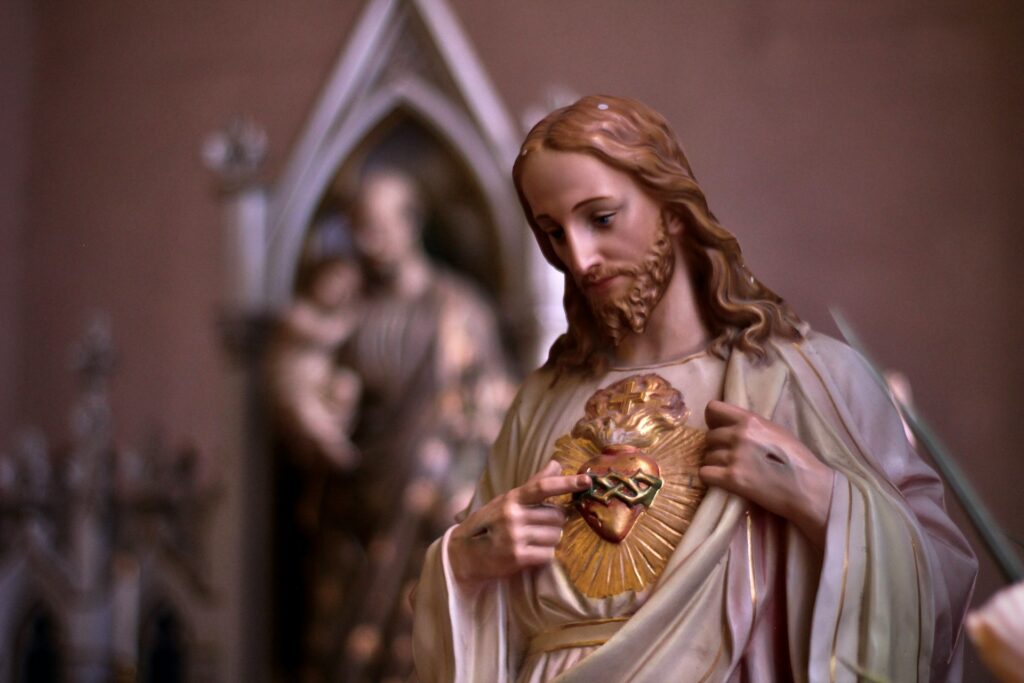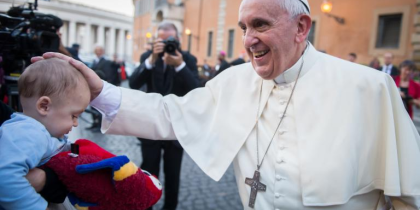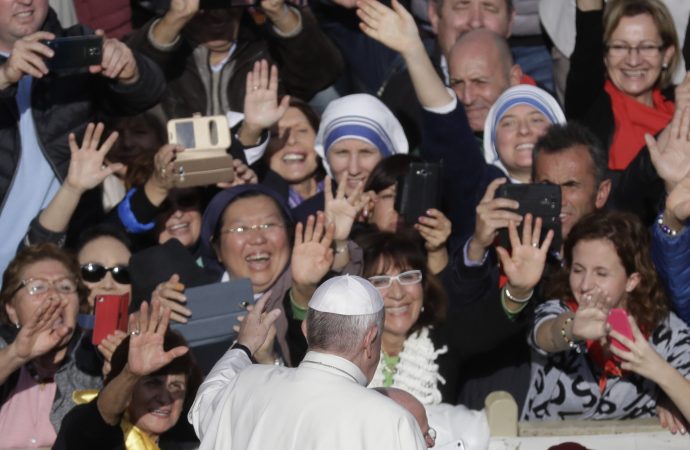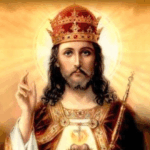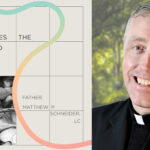Today Pope Francis released Dilexit Nos. It is an encyclical on the Sacred Heart, which asks us to go deeper spiritually and make a deeper conversion to Christ. I suspect Francis has a deep devotion to Christ’s heart from how he writes. Dilexit Nos should be welcomed by all Catholics: even if you aren’t a big Francis fan, I think the spiritual reflection can be helpful. I will follow my pattern of summarizing it mainly using direct quotations over my own interpretation. This is 4,850 words or about 1/6 of the encyclical.
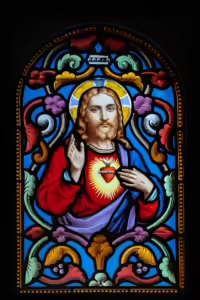
Dilexit Nos has 5 chapters:
- The Importance of the Heart: this gives a background on what we mean by the heart
- Actions and Words of Love: this focuses on Jesus’s actions related to his heart
- This Heart That Has Loved So Greatly: this looks at the actual image and devotion to Christ’s heart
- A Love That Gives Itself to Drink: this looks at the devotion of various saints and mystics to the Sacred Heart
- Love for Love: this talks about what actions should flow from devotion
Chapters 4 and 5 are the longest.
The Importance of the Heart (Dilexit Nos 1)
Pope Francis begins with how the Sacred Heart responds to our broken world.
The symbol of the heart has often been used to express the love of Jesus Christ… Living as we do in an age of superficiality, rushing frenetically from one thing to another without really knowing why, and ending up as insatiable consumers and slaves to the mechanisms of a market unconcerned about the deeper meaning of our lives, all of us need to rediscover the importance of the heart. (2)
Then he moves to the idea of the heart historically:
In classical Greek, the word kardía denotes the inmost part of human beings, animals and plants. For Homer, it indicates not only the centre of the body, but also the human soul and spirit… In Plato, the heart serves, as it were, to unite the rational and instinctive aspects of the person, since the impulses of both the higher faculties and the passions were thought to pass through the veins that converge in the heart. (3)
Personal Life and the Heart
Then Francis moves to our personal life:
The heart is also the locus of sincerity, where deceit and disguise have no place. It usually indicates our true intentions, what we really think, believe and desire, the “secrets” that we tell no one: in a word, the naked truth about ourselves. (5) […]
Instead of running after superficial satisfactions and playing a role for the benefit of others, we would do better to think about the really important questions in life. Who am I, really? What am I looking for? What direction do I want to give to my life, my decisions and my actions? Why and for what purpose am I in this world? How do I want to look back on my life once it ends? What meaning do I want to give to all my experiences? Who do I want to be for others? Who am I for God? All these questions lead us back to the heart. (8)
He asks us to be ruled not by passions but by mind and heart. “Political rule” here refers to it ruling over justly: it should have concern for lower parts of our nature, but not be overcome by them.
All our actions need to be put under the “political rule” of the heart. In this way, our aggressiveness and obsessive desires will find rest in the greater good that the heart proposes and in the power of the heart to resist evil. The mind and the will are put at the service of the greater good by sensing and savouring truths, rather than seeking to master them as the sciences tend to do. The will desires the greater good that the heart recognizes, while the imagination and emotions are themselves guided by the beating of the heart. (13)
For Francis, the Sacred Heart is theological in that it is beyond human reason or philosophy:
Where the thinking of the philosopher halts, there the heart of the believer presses on in love and adoration, in pleading for forgiveness and in willingness to serve in whatever place the Lord allows us to choose, in order to follow in his footsteps. At that point, we realize that in God’s eyes we are a “Thou”, and for that very reason we can be an “I”. Indeed, only the Lord offers to treat each one of us as a “Thou”, always and forever. Accepting his friendship is a matter of the heart; it is what constitutes us as persons in the fullest sense of that word.
Society and the Heart
Instead, we live in a society against the heart:
A society dominated by narcissism and self-centredness will increasingly become “heartless”. This will lead in turn to the “loss of desire”, since as other persons disappear from the horizon we find ourselves trapped within walls of our own making, no longer capable of healthy relationships. As a result, we also become incapable of openness to God. (17)
Francis wants us instead to have a society based on the heart:
It is only by starting from the heart that our communities will succeed in uniting and reconciling differing minds and wills, so that the Spirit can guide us in unity as brothers and sisters. Reconciliation and peace are also born of the heart. The heart of Christ is “ecstasy”, openness, gift and encounter. In that heart, we learn to relate to one another in wholesome and happy ways, and to build up in this world God’s kingdom of love and justice. Our hearts, united with the heart of Christ, are capable of working this social miracle. (24) […]
In the end, that Sacred Heart is the unifying principle of all reality, since “Christ is the heart of the world, and the paschal mystery of his death and resurrection is the centre of history, which, because of him, is a history of salvation”. All creatures “are moving forward with us and through us towards a common point of arrival, which is God, in that transcendent fullness where the risen Christ embraces and illumines all things.” (31)
As can be seen, this first chapter of Dilixet Nos presents a backdrop of the heart. The focus here is not the Sacred Heart itself, but the heart of humans in general. The Pope is wise not to talk about the Sacred Heart there apart from human hearts more generally.
Actions and Words of Love (Dilexit Nos 2)
This chapter begins with why we use Christ’s heart:
The heart of Christ, as the symbol of the deepest and most personal source of his love for us, is the very core of the initial preaching of the Gospel. It stands at the origin of our faith, as the wellspring that refreshes and enlivens our Christian beliefs. (32)
Jesus’ Actions and Words
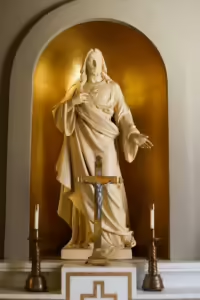
Pope Francis moves to Jesus’ actions showing his love. He points to Jesus touching people not just loving from afar:
Whenever Jesus healed someone, he preferred to do it, not from a distance but in close proximity: “He stretched out his hand and touched him” (Mt 8:3). “He touched her hand” (Mt 8:15). “He touched their eyes” (Mt 9:29). Once he even stopped to cure a deaf man with his own saliva (cf. Mk 7:33), as a mother would do, so that people would not think of him as removed from their lives. “The Lord knows the fine science of the caress. In his compassion, God does not love us with words; he comes forth to meet us and, by his closeness, he shows us the depth of his tender love” (36)
Jesus was attentive to others:
Many a page of the Gospel illustrates how attentive Jesus was to individuals and above all to their problems and needs. We are told that, “when he saw the crowds, he had compassion for them, because they were harassed and helpless” (Mt 9:36). Whenever we feel that everyone ignores us, that no one cares what becomes of us, that we are of no importance to anyone, he remains concerned for us. To Nathanael, standing apart and busy about his own affairs, he could say, “I saw you under the fig tree before Philip called you” (Jn 1:48). (40)
Francis then moves on to Jesus’ words. Jesus’ words included emotions.
Jesus’ words show that his holiness did not exclude deep emotions. On various occasions, he demonstrated a love that was both passionate and compassionate. He could be deeply moved and grieved, even to the point of shedding tears. It is clear that Jesus was not indifferent to the daily cares and concerns of people, such as their weariness or hunger: “I have compassion for this crowd… they have nothing to eat… they will faint on the way, and some of them have come from a great distance” (Mk 8:2-3). (44)
We can see in this chapter of Dilexit Nos that Jesus is moved by the heart. He is devoted in word and actions to caring for others. These first two chapters form the foundation so later chapters can go into the devotion more specifically.
This Heart That Has Loved So Greatly (Dilexit Nos 3)
This chapter begins by briefly describing this devotion:
Devotion to the heart of Christ is not the veneration of a single organ apart from the Person of Jesus. What we contemplate and adore is the whole Jesus Christ, the Son of God made man, represented by an image that accentuates his heart. That heart of flesh is seen as the privileged sign of the inmost being of the incarnate Son and his love, both divine and human. More than any other part of his body, the heart of Jesus is “the natural sign and symbol of his boundless love”. (48)
Images of the Sacred Heart
Pope Francis points out that images should point to reality:
While the image of Christ and his heart is not in itself an object of worship, neither is it simply one among many other possible images. It was not devised at a desk or designed by an artist; it is “no imaginary symbol, but a real symbol which represents the centre, the source from which salvation flowed for all humanity”. (52)
In this topic, he writes the one line that I think might be most controversial in the encyclical. It seems that he would discourage images of the Sacred Heart which are just the heart, only encouraging those where the heart is attached to a fuller image of Jesus.

It is understandable, then, that the Church has chosen the image of the heart to represent the human and divine love of Jesus Christ and the inmost core of his Person. Yet, while the depiction of a heart afire may be an eloquent symbol of the burning love of Jesus Christ, it is important that this heart not be represented apart from him. In this way, his summons to a personal relationship of encounter and dialogue will become all the more meaningful. The venerable image portraying Christ holding out his loving heart also shows him looking directly at us, inviting us to encounter, dialogue and trust; it shows his strong hands capable of supporting us and his lips that speak personally to each of us. (54)
This is the one part I’m not certain about. I don’t see the issue with an image of Just the Sacred Heart without the rest of Jesus’ body. I can see giving a priority that those include the whole body but I see no point in restricting other images.
EDIT: the footnote clarifies that this is about not using the heart alone in liturgy, but such images are fine for personal devotion and prayer. I missed that.
He also wants us to not be caught up with bad artists:
Certain of these representations may indeed strike us as tasteless and not particularly conducive to affection or prayer. Yet this is of little importance, since they are only invitations to prayer, and, to cite an Eastern proverb, we should not limit our gaze to the finger that points us to the moon… The image we venerate… serves as a summons to make room for an encounter with Christ, and to worship him in whatever way we wish to picture him. (57)
Speaking of the Sacred Heart
Pope Francis points us to the great minds reminding us of Jesus’ humanity:
The Fathers of the Church, opposing those who denied or downplayed the true humanity of Christ, insisted on the concrete and tangible reality of the Lord’s human affections. Saint Basil emphasized that the Lord’s incarnation was not something fanciful, and that “the Lord possessed our natural affections”. Saint John Chrysostom pointed to an example: “Had he not possessed our nature, he would not have experienced sadness from time to time”. Saint Ambrose stated that “in taking a soul, he took on the passions of the soul” (62)
Dilexit Nos speaks of three loves in the image of the Sacred Hert:
The image of the Lord’s heart speaks to us in fact of a threefold love. First, we contemplate his infinite divine love. Then our thoughts turn to the spiritual dimension of his humanity, in which the heart is “the symbol of that most ardent love which, infused into his soul, enriches his human will”. Finally, “it is a symbol also of his sensible love”.
These three loves are not separate, parallel or disconnected, but together act and find expression in a constant and vital unity. (65-66)
Our devotion to the Sacred Heart should lead us to love the Father:
Devotion to the heart of Jesus, as a direct contemplation of the Lord that draws us into union with him, is clearly Christological in nature… Jesus wants to bring us to the Father. That is why, from the very beginning, the Church’s preaching does not end with Jesus, but with the Father. As source and fullness, the Father is ultimately the one to be glorified. (70)
Church Teaching and the Sacred Heart
Francis then reminds us of the magisterium on the Sacred Heart:
In numerous ways, Christ’s heart has always been present in the history of Christian spirituality. In the Scriptures and in the early centuries of the Church’s life, it appeared under the image of the Lord’s wounded side, as a fountain of grace and a summons to a deep and loving encounter. In this same guise, it has reappeared in the writings of numerous saints, past and present. In recent centuries, this spirituality has gradually taken on the specific form of devotion to the Sacred Heart of Jesus. (78) […]
Benedict XVI asked us to recognize in the heart of Christ an intimate and daily presence in our lives: “Every person needs a ‘centre’ for his or her own life, a source of truth and goodness to draw upon in the events, situations and struggles of daily existence.” (81)
Francis also wants to warn us about dangers. One he notes and I see with online Catholics is neo-Jansenism:
I must warn that within the Church too, a baneful Jansenist dualism has re-emerged in new forms. This has gained renewed strength in recent decades, but it is a recrudescence of that Gnosticism which proved so great a spiritual threat in the early centuries of Christianity because it refused to acknowledge the reality of “the salvation of the flesh”. For this reason, I turn my gaze to the heart of Christ and I invite all of us to renew our devotion to it. I hope this will also appeal to today’s sensitivities and thus help us to confront the dualisms, old and new, to which this devotion offers an effective response. (87)
This chapter of Dilexit Nos gives us the basic idea of the image of the Sacred Heart and devotion to Christ’s Heart. It begins pointing to the consequences of such devotion but leaves most of that for the last two chapters.
A Love That Gives Itself As Drink (Dilexit Nos 4)
This chapter focuses on various saints. I will not include all of them, but you can read this whole chapter in Dilexit Nos if it interests you.
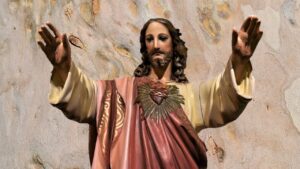
Before going onto the saints, he brings in the Bible.
The Jewish festival of Booths ( Sukkot), which recalls the forty-year sojourn of Israel in the desert, gradually adopted the symbolism of water as a central element…
The dawn of the messianic era was described as a fountain springing up for the people: “I will pour out a spirit of compassion and supplication on the house of David and the inhabitants of Jerusalem, and they shall look on him whom they have pierced… On that day, a fountain shall be opened for the house of David and the inhabitants of Jerusalem, to cleanse them from sin and impurity” (Zech 12:10; 13:1).
One who is pierced, a flowing fountain, the outpouring of a spirit of compassion and supplication: the first Christians inevitably considered these promises fulfilled in the pierced side of Christ, the wellspring of new life. In the Gospel of John, we contemplate that fulfilment. (94-96)
Early Devotion in the Church
For the medieval period, one saint he mentions is Bonaventure:
Saint Bonaventure… presents the heart of Christ as the source of the sacraments and of grace, and urges that our contemplation of that heart become a relationship between friends, a personal encounter of love. (106)
Pope Francis also talks about mystical experiences:
A number of holy women, in recounting their experiences of encounter with Christ, have spoken of resting in the heart of the Lord as the source of life and interior peace. (110)
Saint Margaret Mary Alacoque
Saint Margaret Mary Alacoque is the main person most modern Sacred Heart devotion is traced back to, so Francis speaks about her visions. He speaks of her first vision of Jesus’ unquenchable love
Jesus said: “My divine Heart is so inflamed with love for men, and for you in particular, that, no longer able to contain in itself the flames of its ardent charity, it must pour them out through you and be manifested to them, in order to enrich them with its precious treasures which I now reveal to you”. (119)
Francis continues summarizing St. Margaret Mary:
Saint Margaret Mary’s account is powerful and deeply moving: “He revealed to me the wonders of his love and the inexplicable secrets of his Sacred Heart which he had hitherto kept hidden from me, until he opened it to me for the first time, in such a striking and sensible manner that he left me no room for doubt”. In subsequent appearances, that consoling message was reiterated: “He revealed to me the ineffable wonders of his pure love and to what extremes it had led him to love mankind”. (120) […]
In the first message that Saint Margaret Mary received…, “He asked for my heart, which I asked him to take, which he did and then placed myself in his own adorable heart, from which he made me see mine like a little atom consumed in the fiery furnace of his own”. (123)
We should be open to giving our full hearts to Jesus.
Other Saints
Francis moves on to St. Charles de Foucauld who was encouraged by his cousin Marie to be devoted to the Sacred Heart:
What Marie awakened in him was an intense awareness of the love of Jesus. That was the essential thing, and centred on devotion to the heart of Jesus, in which he encountered unbounded mercy: “Let us trust in the infinite mercy of the one whose heart you led me to know”. (130)
St. Therese of Lisieux shows us devotion from early in her life. As the Pope explains:
When Therese was fifteen, she could speak of Jesus as the one “whose heart beats in unison with my own”. Two years later, speaking of the image of Christ’s heart crowned with thorns, she wrote in a letter: “You know that I myself do not see the Sacred Heart as everyone else. I think that the Heart of my Spouse is mine alone, just as mine is his alone, and I speak to him then in the solitude of this delightful heart to heart, while waiting to contemplate him one day face to face”. (134)
St. Therese also shows confidence in loving Jesus in his Sacred Heart.
In a letter to Father Adolphe Roulland she writes, “[M]y way is all confidence and love. I do not understand souls who fear a friend so tender. At times, when I am reading certain spiritual treatises in which perfection is shown through a thousand obstacles, surrounded by a crowd of illusions, my poor little mind quickly tires; I close the learned book that is breaking my head and drying up my heart, and I take up Holy Scripture. Then all seems luminous to me; a single word uncovers for my soul infinite horizons, perfection seems simple to me. I see that it is sufficient to recognize one’s nothingness and to abandon oneself like a child into God’s arms”. (141)
Consoling Jesus’ Heart
Consoling Sacred Heart for sins committed had been a common devotion, but has been slowly pushed a little to the side. Pope Francis wants us to bring it back:
It is fitting to recover one particular aspect of the spirituality that has accompanied devotion to the heart of Christ, namely, the interior desire to offer consolation to that heart. Here I will not discuss the practice of “reparation”, which I deem better suited to the social dimension of this devotion to be discussed in the next chapter. I would like instead to concentrate on the desire often felt in the hearts of the faithful who lovingly contemplate the mystery of Christ’s passion and experience it as a mystery which is not only recollected but becomes present to us by grace, or better, allows us to be mystically present at the moment of our redemption. If we truly love the Lord, how could we not desire to console him? (152)
This should not be solitary but share our spiritual experience.
When we live in God’s grace, this mutual sharing becomes for us a spiritual experience. In a word, the risen Lord, by the working of his grace, mysteriously unites us to his passion. The hearts of the faithful, who experience the joy of the resurrection, yet at the same time desire to share in the Lord’s passion, understand this. They desire to share in his sufferings by offering him the sufferings, the struggles, the disappointments and the fears that are part of their own lives. Nor do they experience this as isolated individuals, since their sufferings are also a participation in the suffering of the mystical Body of Christ, the holy pilgrim People of God, which shares in the passion of Christ in every time and place. The devotion of consolation, then, is in no way ahistorical or abstract; it becomes flesh and blood in the Church’s pilgrimage through history. (157)
This chapter of Dilexit Nos is the most mystical and spiritual. It reminds us of the origin of this devotion with the saints, and its continuation in our acts.
Love For Love (Dilexit Nos 5)
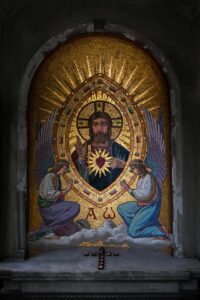
The experience of the Sacred Heart should push us towards helping others. Francis notes this starting with St. Margaret Mary’s experience.
In the spiritual experiences of Saint Margaret Mary Alacoque, we encounter, along with an ardent declaration of love for Jesus Christ, a profoundly personal and challenging invitation to entrust our lives to the Lord. The knowledge that we are loved, and our complete confidence in that love, in no way lessens our desire to respond generously, despite our frailty and our many shortcomings. (164)
Looking at the Sacred Heart and offering Jesus prayers through it, we should transform our hearts into his. This should move us to work:
Love for our brothers and sisters is not simply the fruit of our own efforts; it demands the transformation of our selfish hearts. This realization gave rise to the oft-repeated prayer: “Jesus, make our hearts more like your own”. Saint Paul, for his part, urged his hearers to pray not for the strength to do good works, but “to have the same mind among you that was in Christ Jesus” (Phil 2:5). (168)
Reparation to the Sacred Heart
He gets back to how we should offer reparation to the Sacred Heart.
Although “the sacrifice offered on the cross in loving obedience renders most abundant and infinite satisfaction for the sins of mankind”, the Church, born of the heart of Christ, prolongs and bestows, in every time and place, the fruits of that one redemptive passion, which lead men and women to direct union with the Lord. (175)
St. Charles de Foucauld comes back as an example of such reparation.
Saint Charles de Foucauld sought to imitate Jesus by living and acting as he did, in a constant effort to do what Jesus would have done in his place. Only by being conformed to the sentiments of the heart of Christ could he fully achieve this goal. Here too we find the idea of “love for love”. In his words, “I desire sufferings in order to return love for love, to imitate him… to enter into his work, to offer myself with him, the nothingness that I am, as a sacrifice, as a victim, for the sanctification of men”. (179)
The Pope reminds us we need to actually carry our crosses if we want to do reparation to the Sacred Heart.
Good intentions are not enough. There has to be an inward desire that finds expression in our outward actions. “Reparation, if it is to be Christian, to touch the offended person’s heart and not be a simple act of commutative justice, presupposes two demanding things: acknowledging our guilt and asking forgiveness… It is from the honest acknowledgment of the wrong done to our brother or sister, and from the profound and sincere realization that love has been compromised, that the desire to make amends arises”. (187)
Spreading Devotion to the Sacred Heart
Jesus’ love is unquenchable. As it is represented by his heart, we need to share the Sacred Heart.
Saint Margaret Mary recounted that, in one of Christ’s appearances, he spoke of his heart’s passionate love for us, telling her that, “unable to contain the flames of his burning charity, he must spread them abroad”. Since the Lord, who can do all things, desired in his divine freedom to require our cooperation, reparation can be understood as our removal of the obstacles we place before the expansion of Christ’s love in the world by our lack of trust, gratitude and self-sacrifice. (194)
Pope Francis also reminds us that the Sacred Heart can motivate us to evangelize.
Saint Paul VI, addressing religious Congregations dedicated to the spread of devotion to the Sacred Heart, made the following observation. “There can be no doubt that pastoral commitment and missionary zeal will fan into flame, if priests and laity alike, in their desire to spread the glory of God, contemplate the example of eternal love that Christ has shown us, and direct their efforts to make all men and women sharers in the unfathomable riches of Christ”. (208)
Finally, he notes this devotion is not solitary.
We should not think of this mission of sharing Christ as something only between Jesus and me. Mission is experienced in fellowship with our communities and with the whole Church. If we turn aside from the community, we will be turning aside from Jesus. If we turn our back on the community, our friendship with Jesus will grow cold. This is a fact, and we must never forget it. Love for the brothers and sisters of our communities – religious, parochial, diocesan and others – is a kind of fuel that feeds our friendship with Jesus. Our acts of love for our brothers and sisters in community may well be the best and, at times, the only way that we can witness to others our love for Jesus Christ. He himself said, “By this everyone will know that you are my disciples, if you have love for one another” (Jn 13:35). (212)
This final chapter of Dilexit Nos focuses on our response to the Sacred Heart. The Pope seems to go back to making reparation to Jesus’ heart and to the love of his heart moving us to evangelize.
Overall, I think Dilexit Nos is good spiritual reading for most Catholics. With the possible exception of criticizing images of the Sacred Heart detached from the body, nothing seems particularly new. However, it is often very good to go over basic truths or renew practices that have been partially forgotten. Sacred Heart of Jesus, I trust in You. Sacred Heart of Jesus, make my heart like Thine.
